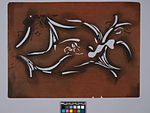Stencil
About this object
History of use
The katazome method of dying fabric used a resist paste applied through a stencil; when the paste dried the stencil was removed and colour was applied by brush. The paste was then washed away leaving undyed areas to form pattern against coloured ground. Prior to the 16th century cut stencils were used to colour leather armour. However, during the Edo Period (1603-1868) the technique was developed as a true native craft.
Cultural context
fabric printing
Iconographic meaning
Iris: success, associated with boy's festival in may.
Physical description
The rectangular stencil has a cut design of an iris pattern. As well, part of the pattern is painted but uncut. There are six register points, with two points in two quadrants and one point in the other two quadrants. Two triangular notches are cut out along one long side edge. There is black dye stain around pattern and marks along one short side edge.
Categories
Materials
Cut Laminated Smoked Dried / paper Persimmon juice
